The Yellow Vests: A Social Insurrection
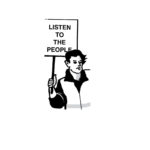
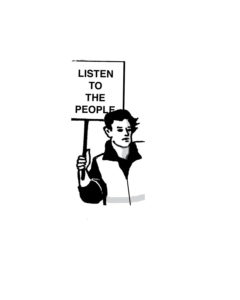 On May 7, 2017, the property-owning classes of France had smiles on their lips. Emmanuel Macron had been elected president with 63.90 percent of the vote against the extreme-right candidate Marine Le Pen, who had won 36.10 percent. Given his victory, most of the analysts preferred to forget the 23.72 percent of the vote won by Macron in the first round and above all that one out of four voters had not cast ballots (the greatest number of abstentions since 1969). Macron’s victory led to the collapse of the Socialist Party after five years in power as well as to that of the classic right-wing party, the Republicans, to the benefit of his party, the Republic in Motion (La République en Marche), which now resembled the former membership of the Socialists and of the classic right. This spectacular political reorganization, linked to the exhaustion of the social democratic model and the crack up of the classical right after its repeated failures (ten years out of power), hardly masked the reactionary nature of the politics pursued by the new power.
On May 7, 2017, the property-owning classes of France had smiles on their lips. Emmanuel Macron had been elected president with 63.90 percent of the vote against the extreme-right candidate Marine Le Pen, who had won 36.10 percent. Given his victory, most of the analysts preferred to forget the 23.72 percent of the vote won by Macron in the first round and above all that one out of four voters had not cast ballots (the greatest number of abstentions since 1969). Macron’s victory led to the collapse of the Socialist Party after five years in power as well as to that of the classic right-wing party, the Republicans, to the benefit of his party, the Republic in Motion (La République en Marche), which now resembled the former membership of the Socialists and of the classic right. This spectacular political reorganization, linked to the exhaustion of the social democratic model and the crack up of the classical right after its repeated failures (ten years out of power), hardly masked the reactionary nature of the politics pursued by the new power.
From the minute Macron and his party came to power, they reduced taxes on the rich. Retirees saw their pensions heavily taxed. Housing assistance was reduced. Consistent with the power politics of their socialist predecessor, François Hollande, they passed a second labor-law reform that eviscerated workers’ rights. The same with the privatization of the railroads, which had already been decided. Both of those counter-reforms had run into resistance from the workers and their unions, but each time they were defeated. The unions fought, but who could oppose Macron? The way had been opened to a violent, liberal politics. And since no obstacle had arisen, this power rapidly became arrogant. In terms of a social movement, there is no seismograph, and Macron didn’t have one either. After 18 months of Macron in power, a large-scale social outburst, unprecedented and prolonged, would upset the plans of the powerful: the Yellow Vests.
We sometimes say that a single drop of water can make a glass overflow. In October 2018 it was a drop of gasoline. In deciding to increase the tax on fuel as of January 1, 2019, and therefore increase the price of gas on the pretext of financing an ecological transition to respond to climate change, the government unleashed the anger of some of the poorest people in the country. France is a country with more than nine million inhabitants below the poverty line for whom the use of a car is a vital necessity. The most impoverished layers have, over many years, been driven out of the urban centers by real estate speculation and rising rents. Some businesses also disappeared or moved farther away, taking the jobs with them. Many people moved to small towns and rural areas where one needs a car to get to public services (schools and the post office) and health care (doctors, hospitals, maternity care). If one can’t get around by car, one slips down into a lower class. Geographic isolation added to social isolation, so one of the first results of this movement was to break out of this loneliness. The Yellow Vests occupied the traffic circles that exist throughout the country, and a new community was born. A sense of solidarity developed, and a shared social consciousness emerged. This also explains why the Yellow Vest movement hasn’t touched the big urban centers (in particular Paris and its suburbs), whose residents suffer less from an increase in the price of fuel since they have more-developed public transportation.
Let’s follow the train of events. On October 18, 2017, Jacline Mouraud published a video on Facebook that denounced the tax increase—it was seen six million times, that is, by almost 10 percent of France’s 67 million inhabitants. Three days later, a petition, “For the Lowering of the Price of Fuel,” launched by Priscillia Ludosky, received two million signatures. On Saturday, November 17, the first day of roadblocks took place. The idea of wearing a yellow vest came from another Facebook user, Ghislain Coutard, who suggested the idea in a video published on social media on October 24. Since 2008, all drivers have been required to have a yellow safety vest in their cars. So beginning in November 2018, the vest became the symbol of the socially invisible people, the flag of a social revolt.
Act 1: Saturday, November 17, as arranged by social media, the Yellow Vests assembled at six in the morning. (Every day that there was a national demonstration, almost always on a Saturday, was an “act,” so, for example, April 6, 2019, was Act 21.) Officials calculated that on that first day, 290,000 demonstrators participated sporting their florescent yellow vests. In reality there were three or four times as many. Everywhere in France the Yellow Vests occupied the traffic circles, day and night, constructing yellow shelters as their rallying points. Some of these became meeting places, kitchens, dormitories, and even chicken coops.
The activists’ demands went far beyond the question of the fuel tax. They demanded that Macron resign. They insisted on their right to control their elected representatives. They called for citizens’ right to initiate referendums. This right, which would mean the possibility of initiating a referendum (with a certain number of signatures) to propose a law, to recall a representative, or to change the constitution, had not been discussed since the revolution that established the Paris Commune in 1871.
We should note that the symbolism of the French Revolution has been ever present in the Yellow Vest movement. The national anthem, “La Marseillaise,” is often sung, not as a nationalist melody, but as a revolutionary song. Likewise, the French flag is often carried in the demonstrations. On some traffic circles, effigies of Macron are decapitated, as King Louis XVI was in 1793. Finally, the Yellow Vests have compiled “books of grievances,” using a term from 1789.
According to polls, initially eight out of ten French people supported the movement; more recently the level fell to six out of ten, that is, still a majority of the population after six months of protests. Faced with the movement, the government stated that it would concede nothing. Repression began to fall on the occupied traffic circles and their yellow buildings, which were destroyed. We’ll come back to the repression in a bit.
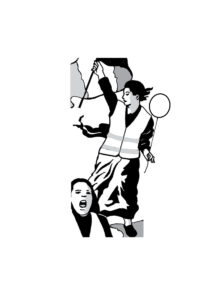 From the beginning, the movement had made its marches down the Champs-Élysées in Paris a powerful symbol. The bourgeois neighborhoods must understand the anger of the people. On November 24, many thousands of demonstrators strongly resisted the police on the Champs-Élysées. On December 1 and 8, the third and fourth Saturdays of the mobilization, several violent events took place, mostly in Paris, where the Arc de Triomphe and other bourgeois neighborhoods practically became scenes of urban guerilla warfare. The police were forced to retreat in several places in the Champs-Élysées district. In Paris the police made nearly 270 arrests. But the confrontations weren’t just confined to Paris. For example in the Puy-en-Velay (in the d’Auvergne region) the county seat (préfecture) was burned. When Macron went there a week later to see the damage, he was forced to flee under a barrage of insults from the crowd. One of his bodyguards later said, “We were ready to shoot.” In Bordeaux, some 2,000 tried to break into the city hall. There were clashes between the Yellow Vests and the police in several cities.
From the beginning, the movement had made its marches down the Champs-Élysées in Paris a powerful symbol. The bourgeois neighborhoods must understand the anger of the people. On November 24, many thousands of demonstrators strongly resisted the police on the Champs-Élysées. On December 1 and 8, the third and fourth Saturdays of the mobilization, several violent events took place, mostly in Paris, where the Arc de Triomphe and other bourgeois neighborhoods practically became scenes of urban guerilla warfare. The police were forced to retreat in several places in the Champs-Élysées district. In Paris the police made nearly 270 arrests. But the confrontations weren’t just confined to Paris. For example in the Puy-en-Velay (in the d’Auvergne region) the county seat (préfecture) was burned. When Macron went there a week later to see the damage, he was forced to flee under a barrage of insults from the crowd. One of his bodyguards later said, “We were ready to shoot.” In Bordeaux, some 2,000 tried to break into the city hall. There were clashes between the Yellow Vests and the police in several cities.
Since the movement began, the government frequently accused the Yellow Vests of being anti-environmentalist because they objected to the fuel tax, which is intended to finance a new program to confront climate change. To all of the slanders, the movement simply responded with its marching chant: “End of the month, end of the world, the same fight.” The protestors stated that they were environmentalists who wanted to defend the planet. Soon it was learned that the tax increase was intended to reduce the government’s deficit, not to improve the environment. The government began to panic. On the one hand it was no longer sure that the police, fatigued and now fearful, could be counted on to stand up to the determined demonstrators, and on the other hand it was clear that the movement was deep and massive.
Given the urgency of the situation, the Macron government decided on December 10 to grant, with certain conditions, a small increase in the minimum wage, an increase paid for by the government, not by the corporations. The bosses were also asked to give Christmas bonuses to their employees, which some companies concerned about the Yellow Vest movement did, so that two million employees received an average of US$506 each. Some ask why the Yellow Vest movement turned against the government and not against the bosses. I think that many of the Yellow Vests, who have seen the inability of the unions to affect the corporations, thought that the government was the weak link in the system. In addition, many of the Yellow Vests don’t have a boss (the retired, the unemployed) and fights waged employer by employer had tended to divide the movement.
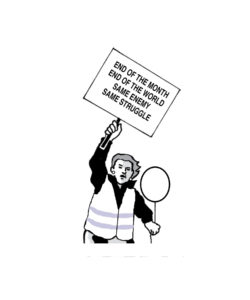 We should also say a few more words about the unions. At the beginning of the movement, one could see some very isolated racist acts or words on the traffic circles. Seeing those racist acts, the union leaders, particularly the General Confederation of Workers (CGT), the largest labor federation that has historically been led by the left, were surprised by the movement, and they were suspicious, fearing that the Yellow Vests had been infiltrated by the far right, even though there were many union members on the traffic circles. The one exception to this was the Solidaires Unitaires Démocratiques (Solidarity Unity Democracy, SUD) union. However, as the movement developed, by January 2019 joint activities had begun among the rank and file Yellow Vests and the unions: blocking refineries, blocking other facilities, joint events, meetings and discussions. This was also true for the parties of the left and even of the far left, who also began to join the movement.
We should also say a few more words about the unions. At the beginning of the movement, one could see some very isolated racist acts or words on the traffic circles. Seeing those racist acts, the union leaders, particularly the General Confederation of Workers (CGT), the largest labor federation that has historically been led by the left, were surprised by the movement, and they were suspicious, fearing that the Yellow Vests had been infiltrated by the far right, even though there were many union members on the traffic circles. The one exception to this was the Solidaires Unitaires Démocratiques (Solidarity Unity Democracy, SUD) union. However, as the movement developed, by January 2019 joint activities had begun among the rank and file Yellow Vests and the unions: blocking refineries, blocking other facilities, joint events, meetings and discussions. This was also true for the parties of the left and even of the far left, who also began to join the movement.
While union acronyms and flags were not at first welcome in the Yellow Vest demonstrations, today they are perfectly acceptable. Yet, the presence of the far right in the movement from the very beginning is undeniable. Fascist activists were, for example, very active in the December demonstrations in the confrontations with the police, and sometimes on the traffic circles one could hear racist words or comments in favor of Marine Le Pen, the leader of the right-wing party. But the center of gravity of the movement has always remained the issue of social justice and not the issue of immigration, despite the efforts of the far right. The movement stifled the far right within it.
The Yellow Vest movement has experienced massive and intense repression. Some figures can give an idea of the magnitude: 2,000 wounded, 23 demonstrators have lost an eye, five have lost a hand. According to the government, some 8,000 people have been arrested and 1,800 have been convicted of various crimes. An elderly woman died in Marseille after police shot a tear-gas grenade into her apartment, while another nine people died in car crashes at the traffic circles occupied by the Yellow Vests. Thousands of Yellow Vests have been clubbed and beaten. Police have fired rubber bullets at demonstrators, using something called an LBD, which fires hard rubber balls at 186 miles per hour. These projectiles have wounded many in their legs and their torsos, not to mention their heads and eyes. Police have also used tear-gas grenades (identified as GLI-F4) with a charge of .84 ounces of TNT. The army was brought out in April 2019 to protect official buildings.
Toward Popular Power?
The occupation of public spaces by a social movement like the Yellow Vests reminds us of the Occupy Wall Street movement or of the occupation of Tahir Square in Egypt. Since the exploited and the oppressed don’t have either an organization or a place where they can give voice to their grievances and make their demands, they take over the public space. On hundreds of traffic circles they created self-organized structures where they are in constant debate. They decided on the actions to carry out.
A new direct democracy is being constructed in which people from various backgrounds are rediscovering class unity. Many women, single heads of households who are raising their children and who find it very hard to make a living, are involved in the movement and have sometimes organized their own events. Many say that by the fifteenth of the month they are broke and have to take out loans, they can’t take vacations, and can’t provide a Christmas for their children. Other groups involved in these demonstrations on the traffic circles are retirees, poor workers, artisans, and the unemployed. And then too there are the high-school students who protested and were arrested and corralled in December. Most of these people say that they have never demonstrated before and have never belonged to a labor union or a political party, though they show remarkable political savvy.
Throughout France the level of organization is high. But among the many experiences of self-organized structures, one is particularly rich, that of the House of the People of Saint-Nazaire. At Saint-Nazaire, a working-class port town of 70,000 people (with about 120,000 in the area), where unemployment has been higher than the national average, the Yellow Vests decided on November 24 to take over an abandoned administrative building and to baptize it the “House of the People.”
They created meeting rooms on two floors. In this new place they organized film showings, theatrical events, concerts, and discussions of literature. But the House is above all the place where actions are organized, such as the blocking of traffic circles and blocking of the port, where they join with the labor unions. They have carried out one action after another for four months. For example, one day they painted the bank facades yellow to protest against capitalist pressure on local residents and against bank charges.
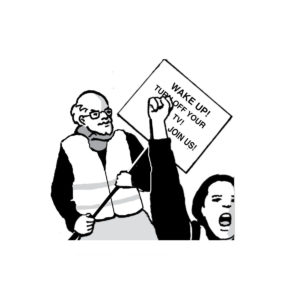 Nearly every day the Yellow Vests in Saint-Nazaire hold a general assembly and publish the decisions on Facebook, which permits a day-by-day account of House of the People’s actions. As everywhere else, there is a demand for Macron’s resignation. But there are other demands, for example, demands for an increase in wages, a lowering of the prices of basic necessities (fuel, water, electricity, housing, and so on), the restoration of the tax on the rich, and measures against tax evasion in order to finance public services and the energy transition. There are also calls for the egalitarian sharing of wealth; the development of renewable energy; the nationalization of the energy sector, banks, and highways; the right to recall elected officials at all levels; as well as many other social and political demands. These are the demands that one finds throughout France.
Nearly every day the Yellow Vests in Saint-Nazaire hold a general assembly and publish the decisions on Facebook, which permits a day-by-day account of House of the People’s actions. As everywhere else, there is a demand for Macron’s resignation. But there are other demands, for example, demands for an increase in wages, a lowering of the prices of basic necessities (fuel, water, electricity, housing, and so on), the restoration of the tax on the rich, and measures against tax evasion in order to finance public services and the energy transition. There are also calls for the egalitarian sharing of wealth; the development of renewable energy; the nationalization of the energy sector, banks, and highways; the right to recall elected officials at all levels; as well as many other social and political demands. These are the demands that one finds throughout France.
The Saint-Nazaire House of the People is also internationalist. On December 24 the House published this message of solidarity with Chilean dockworkers: “The Yellow Vests of the Saint-Nazaire support the Chilean workers of Valparaiso, Chile!!!! They occupied their port for 35 days and finally won their struggle!! SOLIDARITY WITH THE ENTIRE WORLD!!!!” They also posted a video of their message being read in Spanish from the first floor of the House of the People. On February 24, 2019, they dedicated an evening to the subject “Rojava [in Kurdish Syria] and the Yellow Vests: A Common Struggle for Democracy?”
In January 2019, the Yellow Vests of Commercy (Meuse) called for an “assembly of assemblies,” a national meeting of the Yellow Vest collectives. “From Commercy, we call for the creation throughout France of popular committees that function as regular general assemblies, places where there is free speech, the right to express oneself, to teach, and to learn.” The call was a success, and the following weekend 75 Yellow Vest collectives met, with some 350 people participating. The final declaration of the meeting read, “We organize ourselves in a democratic way, autonomous and independent. This assembly of assemblies is an important step that allows us to discuss our demands and our action methods. We come together to transform society!” In April, another “assembly of assemblies” took place in Saint-Nazaire with about 800 people representing 200 collectives. The call for that assembly read,
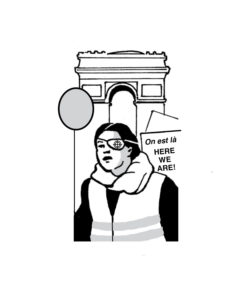 We call upon all regions of the country to collectively fight for the satisfaction of our demands regarding social issues, taxes, the environment, and democracy. Aware that we have to combat a global system, we believe that we must get out of capitalism. … The power of the people, by the people, for the people. Don’t just watch—join us.
We call upon all regions of the country to collectively fight for the satisfaction of our demands regarding social issues, taxes, the environment, and democracy. Aware that we have to combat a global system, we believe that we must get out of capitalism. … The power of the people, by the people, for the people. Don’t just watch—join us.
Where is France going? Are the seeds of a new French revolution just beginning to appear? Born out of a fight about an unjust tax, the movement of the Yellow Vests has provoked a long-lasting social and political crisis. Now the entire system has been called into question. A new social consciousness and political collectivity is appearing. In the dynamic of the movement, the Yellow Vests seem more and more to be a new popular power that demands to control the public power of the government and that insists on controlling its own destiny. Behind the demands, a project for a new society has appeared. The class struggle is back in France.
Translated by Dan La Botz
Patrick Le Tréhondat is a member of the French publishing house Syllepse.